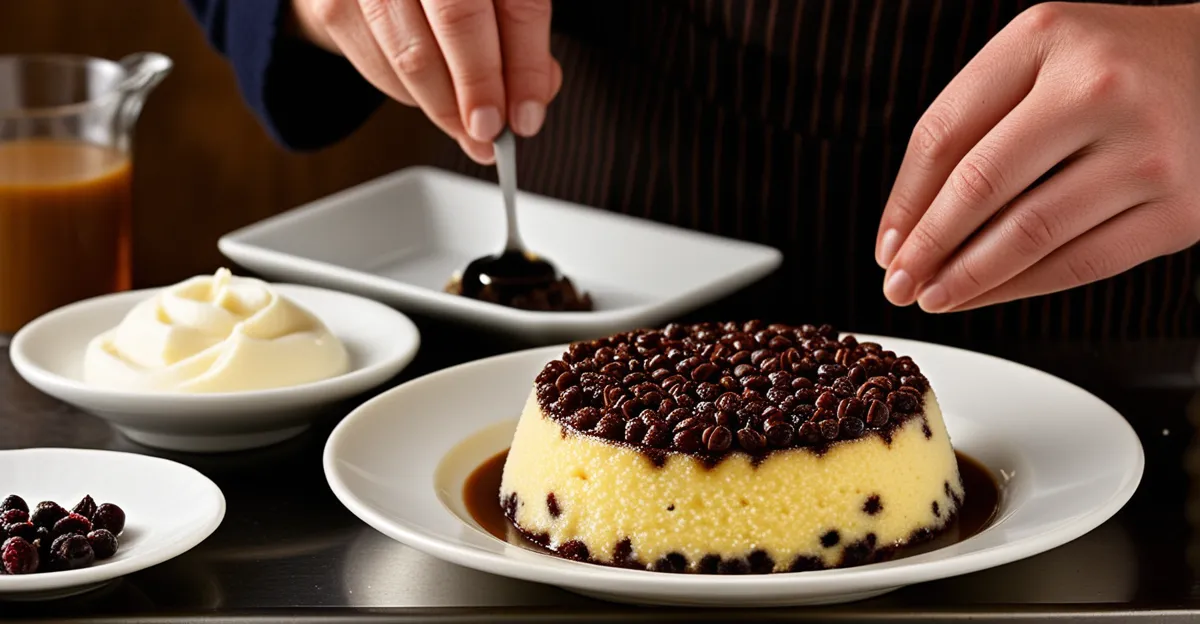Essential Ingredients for Traditional Spotted Dick
The traditional spotted dick ingredients reflect its roots as a beloved classic British pudding. Central to this dried fruit dessert is the use of plain flour, suet, sugar, and a generous amount of currants or raisins—the “spotted” element that gives the pudding its name. Typically, 225g of self-raising flour forms the base, providing lightness, while 100g of shredded suet adds richness and moisture vital for the pudding’s texture.
Suet is crucial because it helps create the traditional crumbly yet moist consistency that distinguishes spotted dick from other puddings. If traditional suet is unavailable, vegetarian suet or grated cold butter can function as effective substitutes without compromising the pudding’s character. The dried fruits—currants or raisins—should be evenly mixed to ensure bursts of sweetness in every bite. Their presence not only imparts flavor but also affects the pudding’s texture, offering delightful chewiness.
Also to read : What Are the Essential Ingredients for Authentic British Cuisine?
Balancing these ingredients is key. Too little suet results in dryness; too few currants lose the defining “spotted” appearance. Understanding this harmony enhances appreciation of this cherished dessert and guides successful preparation.
Essential Ingredients for Traditional Spotted Dick
Spotted dick is a classic British pudding notable for its distinct texture, attributed primarily to its key ingredients. The traditional spotted dick ingredients include plain flour, suet, caster sugar, baking powder, and a generous handful of dried fruit—specifically currants or raisins. These dried fruits are essential in creating the signature “spots” throughout the dessert, contributing both texture and sweetness.
Also to read : How can you put a unique twist on a classic fish and chips recipe?
Suet, traditionally beef or mutton fat, plays a crucial role by providing moisture, richness, and a light, crumbly structure. For those seeking appropriate substitutes, vegetable suet offers a plant-based alternative without sacrificing the pudding’s characteristic texture. Using butter alone won’t replicate the unique consistency suet provides.
Currants or raisins are indispensable as they infuse the batter with bursts of fruity flavor while preserving the pudding’s dense yet moist crumb. Omitting these dried fruit contestants would compromise the authenticity crucial to this dried fruit dessert. Ensuring the correct balance and quality of these ingredients is vital for achieving a true traditional spotted dick experience.
Step-by-Step Preparation and Mixing
Preparing traditional spotted dick begins with making spotted dick dough by combining the dry ingredients such as flour, sugar, and suet before gently folding in the dried fruit dessert elements like currants or raisins. It’s essential to mix thoroughly, ensuring the fruit is evenly distributed to maintain that classic spotted appearance.
Achieving the right pudding preparation consistency requires careful kneading just until the mixture holds together, avoiding overmixing which can lead to a dense texture rather than the traditional light crumb. The dough should be soft but not sticky, allowing it to be easily shaped and placed in a pudding basin.
Traditionally, puddings are steamed in a pudding basin covered with a cloth to retain moisture and create the signature moist texture of a classic British pudding. Alternatively, modern methods may use silicone basins or ovenproof dishes. The covering cloth must be properly secured to prevent water from seeping in, while still allowing steam to circulate, which is crucial for even cooking.
Following these traditional baking methods helps replicate the authentic softness and flavor that define the iconic spotted dick experience.
Essential Ingredients for Traditional Spotted Dick
Understanding the traditional spotted dick ingredients is crucial for recreating this classic British pudding authentically. The foundation typically involves 225g of plain or self-raising flour combined with approximately 100g of shredded suet, which is essential for moisture and a tender crumb. Suet, traditionally derived from beef or mutton fat, is irreplaceable in delivering the pudding’s signature texture. Vegetable suet serves as an effective substitute, particularly for those avoiding animal fats, whereas butter cannot replicate the same richness or structural qualities required in this dried fruit dessert.
Equally vital are currants or raisins, which provide the “spots” that define this pudding. A generous handful ensures bursts of sweetness and a pleasing chewiness throughout the dense batter. Omitting these dried fruits would result in a loss of authenticity and texture, as they balance moisture and flavor naturally. Maintaining precise proportions of these ingredients ensures the pudding is moist without being heavy, a hallmark of traditional spotted dick recipes prized across Britain.
Cooking Methods: Steaming vs. Baking
When considering spotted dick cooking methods, steaming and baking each offer distinct results. Steaming pudding ensures a moist, tender crumb by surrounding the batter with consistent steam heat, preventing drying out. This classic technique uses a covered pudding basin wrapped in cloth or foil, allowing steam to gently cook the dessert evenly. Steaming is ideal for maintaining the traditional British pudding texture—a soft, dense interior that holds its shape when turned out.
Baking spotted dick produces a drier exterior with a slightly firmer crust but risks losing moisture inside if overcooked. Oven temperatures need careful control; typically around 160°C (320°F) with indirect heat or water baths can help retain some moisture. However, baking lacks the gentle humidity of steaming, so the texture differs noticeably.
To set up a steamer, place the pudding basin in a pot with simmering water reaching halfway up the sides. Cover the basin tightly to avoid water ingress but allow steam circulation. Check timing—usually 1.5 to 2 hours—to confirm doneness by testing with a skewer, which should come out clean but moist. These cooking choices significantly influence spotted dick’s texture, so selecting steaming over baking preserves the authentic moist softness prized in this dried fruit dessert.
Essential Ingredients for Traditional Spotted Dick
The traditional spotted dick ingredients are foundational for replicating this classic British pudding with authenticity. Typically, the pudding calls for about 225g of plain or self-raising flour, 100g of shredded suet, and a measured amount of caster sugar. Suet is essential; its unique fat content lends a moist, tender crumb that alternatives like butter cannot mimic. For those seeking vegetarian options, vegetable suet suitably replaces animal fat without sacrificing texture.
Integral to this dried fruit dessert are the currants or raisins, which not only provide the “spots” that give the pudding its name but also impart bursts of subtle sweetness and chewiness. A generous handful ensures even distribution throughout the batter, enhancing both flavor and visual appeal. Omitting or reducing dried fruit compromises the pudding’s distinctive identity and mouthfeel.
Careful balancing of these ingredients is key. Too much suet can make the pudding greasy; insufficient suet leads to dryness. Similarly, currants or raisins must be well mixed into the batter for consistent flavor and texture. Mastering these proportions guarantees the nostalgic taste and satisfying texture characteristic of traditional spotted dick.
Essential Ingredients for Traditional Spotted Dick
The traditional spotted dick ingredients are fundamental in creating this classic British pudding with its distinctive texture and flavor. A typical recipe includes 225g of plain or self-raising flour, 100g of shredded suet, and caster sugar, forming the batter’s base. Suet is essential because it adds moisture and richness, giving the pudding its tender, crumbly structure. While traditional beef or mutton suet is preferred, vegetable suet serves as a suitable alternative for vegetarians, as butter alone cannot achieve the same texture in this dried fruit dessert.
Currants or raisins are the hallmark dried fruit that create the characteristic “spots” in the pudding. These fruits contribute bursts of natural sweetness and chewiness, balancing the dense batter’s moisture. Incorporating the right amount of dried fruit is crucial; too few diminish the pudding’s signature appearance and flavor, while too many can affect its consistency.
Overall, precise measurements and quality of the traditional spotted dick ingredients ensure the pudding retains its authentic moistness and flavor, making it a cherished British classic enjoyed by many.




